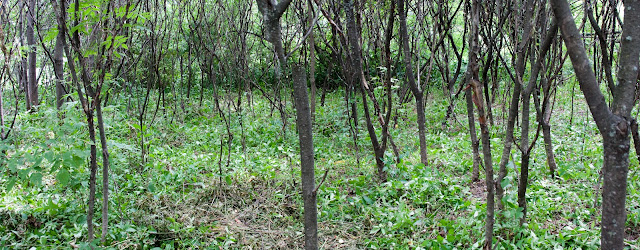Tuesday, August 16
Volunteers: Barry, Glenda, Geoff, Hedrik, Christine, Marg
 We continued working in the fields just north of the Ash Woods and made good progress again. This area is tough going, with bent over DSV, lots of bushes and trees and patches of goldenrod. But we had quite a stack of cut plants by the end of the morning. We're beginning to bag it up now, as seeds are being released. DSV seems to release seeds first closest to the ground, so sometimes we don't see them until the plants are cut and moved. It's still better to take out this material, as the seeds left behind are far fewer than those that would be there if nothing was done.
We continued working in the fields just north of the Ash Woods and made good progress again. This area is tough going, with bent over DSV, lots of bushes and trees and patches of goldenrod. But we had quite a stack of cut plants by the end of the morning. We're beginning to bag it up now, as seeds are being released. DSV seems to release seeds first closest to the ground, so sometimes we don't see them until the plants are cut and moved. It's still better to take out this material, as the seeds left behind are far fewer than those that would be there if nothing was done.
The four of us returned to the IC for our break so that we could have a discussion of our work to date, future goals and how the group is changing over the next while. Glenda is returning to work, so this is most likely her final Tuesday with the group. She has worked very hard and diligently, often the first to arrive and last to leave, so she'll be missed! Barry is away next week and Geoff will be gone the first 3 weeks of September. We took a look at the map and could see where we've been and what's left to do. The upshot of the discussion is that we'll try when we can to make up some of the time that will be lost by coming in as we can at other times.
 |
| BEFORE |
 |
| AFTER |
Christine and Marg worked in a couple of sections of the Old Field, continuing to pull and clip DSV from among the various other plants. They are finding too that seeds are being released and that bagging is becoming an unfortunate necessity.
Thursday, August 18: Barry and Hedrik came in this morning and spent a couple of hours in the hot sun continuing in the central field north of the Ash Woods. Both of us scythed away, managing to avoid the large paper-wasp nest - now marked by a warning sign - and created a new heap of cut DSV plus at least half a dozen bags. We made good progress, but two hours was enough!

























